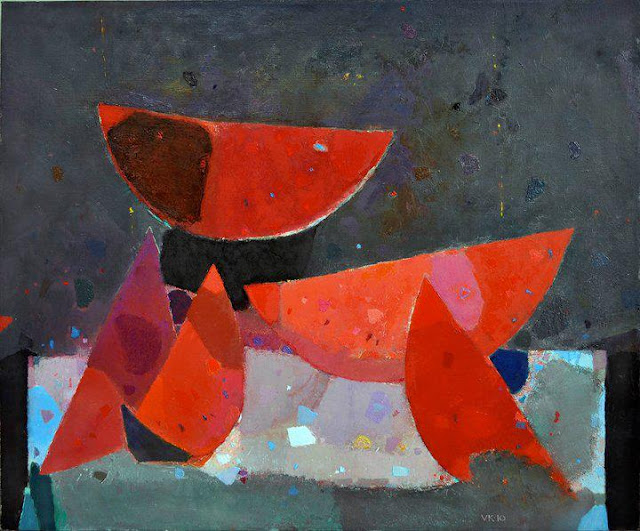Gallen-Kallela was a Finnish artist and designer closely associated
with notions of National Romanticism, especially relating to the region
of Karelia, also a source of inspiration for the Finnish composer Jean
Sibelius. Of particular influence was the collection of folk poems
formed in the middle of the 19th century by Elias Lönrot. Following a
national competition in 1891 Gallen-Kallela illustrated this national
epic known as the Kaleval, the vivid images of which soon became
widely known throughout Finland. He also made a significant contribution
to the Finnish Pavilion at the Paris Exposition Universelle of 1900 in
which he painted frescoes on Kalevala themes in the main dome, as
well as designing textiles and furniture. His furniture designs were
made by the Iris company, founded by a close friend, Louis Sparre. Like
many other ventures associated with Arts and Crafts,
the Iris company was concerned with the production of well-designed,
well-made furniture and ceramics. Gallen-Kallela's designs at Paris 1900
attracted considerable attention leading to the award of a number of
Gold and Silver Medals at the exhibition. He worked in a wide range of
design media, including ryiji rugs, which he modernized using
geometric motifs derived from the Finnish landscape. His distinctive
contribution to Finnish culture is preserved in the Gallen-Kallela
Museum, which was originally built by him as a studio and family home
between 1911 and 1913 and now contains a large body of his work,
including paintings, graphics, textiles, jewellery, stained glass, and
architectural designs.
Despite having studied and lived several times in France, made friends there, decorated the Finnish pavilion for the Exposition universelle of 1900 and participated in the Finnish exhibition for the Salon d’Automne in 1908, Gallen-Kallela has never enjoyed a retrospective in our country up to now. The bibliography is just as poor : there has not been a single publication on his work written entirely in French. This is indeed disappointing given the fact that he was, amid a very rich generation of Finnish artists (Enckell, Edelfelt, Simberg, Halonen, the sculptor Vallgren and many others), the most emblematic of them all. Even more, on certain occasions when some of the painter’s works were included in thematic exhibitions, they were not always welcomed accordingly : for example, and we omit the author’s name in an act of kindness, the statement made in 1998 by a "critic" during the exhibition Visions du nord at the Musée d’art moderne de la Ville de Paris, which presented some of Gallen-Kallela’s canvases : "The Finnish Gallen-Kallela, known for finding his inspiration in the ’national’ legends of the Kalevala, here, is just a painter of colour-prints [chromos] opposing the sensuality of ice cream of a frozen nature to big-game souvenirs brought back from Kenya". It goes without saying that the artist deserved much more than the indifference or pedantry shown until today. The remarkable exhibition at the Musée d’Orsay, which opened first in Helsinki and will then move on to Düsseldorf in June, finally pays due tribute to Gallen-Kallela’s work.
The curators have made a sound decision in restricting the selection to works of the highest quality ; as in the case of any prolific artist, the artistic level can sometimes fluctuate and a monographic exhibition of exhaustive range can dull the image of the painter by reducing the impact of the show’s theme (see the exhibition on Théo van Rysselberghe at the Palais des Beaux-Arts in Brussels, 2006). Here, as in the case of Willumsen or Hodler, the Musée d’Orsay and its partners have selected a series of masterpieces for each period and/or theme : almost 90 items (including decorative arts) illustrate the artistic itinerary and the painter’s unique personality.
Despite having studied and lived several times in France, made friends there, decorated the Finnish pavilion for the Exposition universelle of 1900 and participated in the Finnish exhibition for the Salon d’Automne in 1908, Gallen-Kallela has never enjoyed a retrospective in our country up to now. The bibliography is just as poor : there has not been a single publication on his work written entirely in French. This is indeed disappointing given the fact that he was, amid a very rich generation of Finnish artists (Enckell, Edelfelt, Simberg, Halonen, the sculptor Vallgren and many others), the most emblematic of them all. Even more, on certain occasions when some of the painter’s works were included in thematic exhibitions, they were not always welcomed accordingly : for example, and we omit the author’s name in an act of kindness, the statement made in 1998 by a "critic" during the exhibition Visions du nord at the Musée d’art moderne de la Ville de Paris, which presented some of Gallen-Kallela’s canvases : "The Finnish Gallen-Kallela, known for finding his inspiration in the ’national’ legends of the Kalevala, here, is just a painter of colour-prints [chromos] opposing the sensuality of ice cream of a frozen nature to big-game souvenirs brought back from Kenya". It goes without saying that the artist deserved much more than the indifference or pedantry shown until today. The remarkable exhibition at the Musée d’Orsay, which opened first in Helsinki and will then move on to Düsseldorf in June, finally pays due tribute to Gallen-Kallela’s work.
The curators have made a sound decision in restricting the selection to works of the highest quality ; as in the case of any prolific artist, the artistic level can sometimes fluctuate and a monographic exhibition of exhaustive range can dull the image of the painter by reducing the impact of the show’s theme (see the exhibition on Théo van Rysselberghe at the Palais des Beaux-Arts in Brussels, 2006). Here, as in the case of Willumsen or Hodler, the Musée d’Orsay and its partners have selected a series of masterpieces for each period and/or theme : almost 90 items (including decorative arts) illustrate the artistic itinerary and the painter’s unique personality.

































































































































